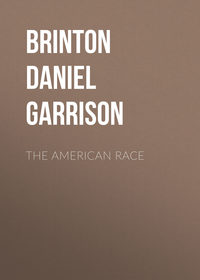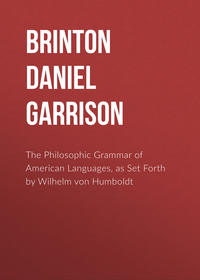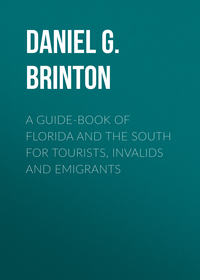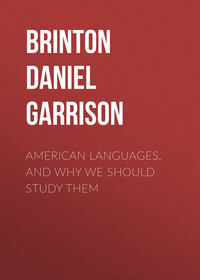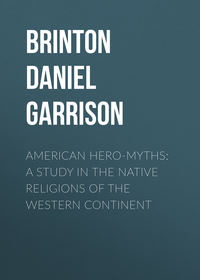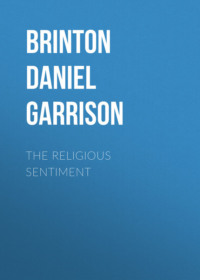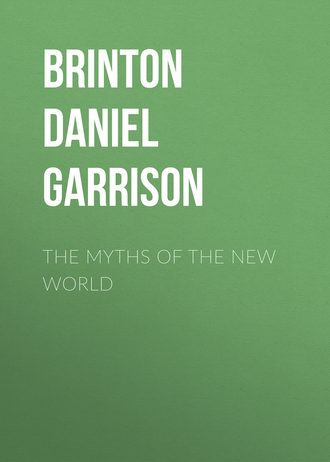 полная версия
полная версияThe Myths of the New World
107
Le Livre Sacré des Quichés, Introd., p. clviii.
108
Memorial de Tecpan Atitlan, in Brasseur, Hist. du Mexique, i. p. 167. The derivation of Tulan, or Tula, is extremely uncertain. The Abbé Brasseur sees in it the ultima Thule of the ancient geographers, which suits his idea of early American history. Hernando De Soto found a village of this name on the Mississippi, or near it. But on looking into Gallatin’s vocabularies, tulla turns out to be the Choctaw word for stone, and as De Soto was then in the Choctaw country, the coincidence is explained at once. Buschmann, who spells it Tollan, takes it from tolin, a rush, and translates, juncetum, Ort der Binsen. Ueber die Aztekischen Orstnamen, p. 682. Those who have attempted to make history from these mythological fables have been much puzzled about the location of this mystic land. Humboldt has placed it on the northwest coast, Cabrera at Palenque, Clavigero north of Anahuac, etc. etc. Aztlan, literally, the White Land, is another name of wholly mythical purport, which it would be equally vain to seek on the terrestrial globe. In the extract in the text, the word translated God is Qabavil, an old word for the highest god, either from a root meaning to open, to disclose, or from one of similar form signifying to wonder, to marvel; literally, therefore, the Revealer, or the Wondrous One (Vocab. de la Lengua Quiché, p. 209: Paris, 1862).
109
Ximenes, Or. de los Indios, p. 80, Le Livre Sacré, p. 195.
110
Garcia, Origen de los Indios, lib. iv. cap. 4.
111
Compare the German expression sich orientiren, to right oneself by the east, to understand one’s surroundings.
112
Hawkins, Sketch of the Creek Country, p. 80.
113
See Jacob Grimm, Geschichte der Deutschen Sprache, p. 681
114
De Smet, Oregon Missions, p. 352.
115
Bressani, Relation Abrégé, p. 93.
116
Venegas, Hist. of California, i. p. 91: London, 1759.
117
Cogolludo, Hist. de Yucathan, lib. iv. cap. iii.
118
Alexander von Humboldt has asserted that the Quichuas had other and very circumstantial terms to express the cardinal points drawn from the positions of the son (Ansichten der Natur, ii. p. 368). But the distinguished naturalist overlooked the literal meaning of the phrases he quotes for north and south, intip chaututa chayananpata and intip chaupunchau chayananpata, literally, the sun arriving toward the midnight, the sun arriving toward the midday. These are evidently translations of the Spanish hacia la media noche, hacia el medio dia, for they could not have originated among a people under or south of the equatorial line.
119
Catlin, Letters and Notes, i., Letter 22; La Hontan, Mémoires, ii. p. 151; Gumilla, Hist. del Orinoco, p. 159
120
On the worship of the cross in Mexico and Yucatan and its invariable meaning as representing the gods of rain, consult Ixtlilxochitl, Hist. des Chichimeques, p. 5; Sahagun, Hist. de la Nueva España, lib. i. cap. ii.; Garcia, Or. de los Indios, lib. iii. cap. vi. p. 109; Palacios, Des. de la Prov. de Guatemala, p. 29; Cogolludo, Hist. de Yucathan, lib. iv. cap. ix.; Villagutierre Sotomayor, Hist. de el Itza y de el Lacandon, lib. iii. cap. 8; and many others might be mentioned.
121
Rivero and Tschudi, Peruvian Antiquities, p. 162, after J. Acosta.
122
Loskiel, Ges. der Miss. der evang. Brüder, p. 60.
123
Hawkins, Sketch of the Creek Country, p. 75. Lapham and Pidgeon mention that in the State of Wisconsin many low mounds are found in the form of a cross with the arms directed to the cardinal points. They contain no remains. Were they not altars built to the Four Winds? In the mythology of the Dakotas, who inhabited that region, the winds were always conceived as birds, and for the cross they have a native name literally signifying “the musquito hawk spread out” (Riggs, Dict. of the Dakota, s. v.). Its Maya name is vahom che, the tree erected or set up, the adjective being drawn from the military language and implying as a defence or protection, as the warrior lifts his lance or shield (Landa, Rel. de las Cosas de Yucatan, p. 65).
124
Squier, The Serpent Symbol in America, p. 98.
125
That these were the real views entertained by the Indians in regard to the brute creation, see Heckewelder, Acc. of the Ind. Nations, p. 247; Schoolcraft, Ind. Tribes, iii. p. 520.
126
Egede, Nachrichten von Grönland, p. 156.
127
Voiages aux Indes Occidentales, pt. ii. p. 203: Amst. 1722.
128
Beverly, Hist. de la Virginie, liv. iii. chap. viii.
129
Schoolcraft, Ind. Tribes, v. p. 420.
130
Mrs. Eastman, Legends of the Sioux, p. 191: New York, 1849. This is a trustworthy and meritorious book, which can be said of very few collections of Indian traditions. They were collected during a residence of seven years in our northwestern territories, and are usually verbally faithful to the native narrations.
131
Müller, Amer. Urreligionen, p. 222, after De la Borde.
132
Acc. of the Inds. of California, ch. ix. Eng. trans. by Robinson: New York, 1847. The Acagchemem were a branch of the Netela tribe, who dwelt near the mission San Juan Capistrano (see Buschmann, Spuren der Aztek. Sprache, etc., p. 548).
133
Called in the Aztec tongue Tecolotl, night owl; literally, the stone scorpion. The transfer was mythological. The Christians prefixed to this word tlaca, man, and thus formed a name for Satan, which Prescott and others have translated “rational owl.” No such deity existed in ancient Anahuac (see Buschmann, Die Voelker und Sprachen Neu Mexico’s, p. 262).
134
Schoolcraft, Ind. Tribes, v. p. 420.
135
William Bartram, Travels, p. 504. Columbus found the natives of the Antilles wearing tunics with figures of these birds embroidered upon them. Prescott, Conq. of Mexico, i. p. 58, note.
136
Rel. de la Nouv. France, An 1636, ch. ix. Catlin, Letters and notes, Lett. 22.
137
Rel. de la Nouv. France, An 1648, p. 75; Cusic, Trad. Hist. of the Six Nations, pt. iii. The latter is the work of a native Tuscarora chief. It is republished in Schoolcraft’s Indian Tribes, but is of little value.
138
For example, in Brazil, Müller, Amer. Urrelig., p. 277; in Yucatan, Cogolludo, Hist. de Yucathan, lib. iv. cap. 4; among the western Algonkins, Hennepin, Decouverte dans l’Amer. Septen. chap. 33. Dr. Hammond has expressed the opinion that the North American Indians enjoy the same immunity from the virus of the rattlesnake, that certain African tribes do from some vegetable poisons (Hygiene, p. 73). But his observation must be at fault, for many travellers mention the dread these serpents inspired, and the frequency of death from their bites, e. g. Rel. Nouv. France. 1667, p. 22.
139
Narrative of the Captivity and Adventures of John Tanner, p. 356.
140
See Gallatin’s vocabularies in the second volume of the Trans. Am. Antiq. Soc. under the word Snake. In Arabic dzann is serpent; dzanan a spirit, a soul, or the heart. So in Hebrew nachas, serpent, has many derivatives signifying to hold intercourse with demons, to conjure, a magician, etc. See Noldeke in the Zeitschrift für Voelkerpsychologie und Sprachwissenschaft, i. p. 413.
141
Alexander Henry, Travels, p. 117.
142
Bost. Med. and Surg. Journal, vol. 76, p. 21.
143
Schwarz, Der Ursprung der Mythologie dargelegt an Griechischer und Deutscher Sage: Berlin, 1860, passim.
144
Rel. de la Nouv. France: An 1637, p. 53.
145
Sagen der Nord-Amer. Indianer, p. 21. This is a German translation of part of Jones’s Legends of the N. Am. Inds.: London, 1820. Their value as mythological material is very small.
146
Torquemada, Monarquia Indiana, lib. vi. cap. 37.
147
Müller, Amer. Urrelig., 221, after De la Borde.
148
Le Livre Sacré des Quichés, p. 3.
149
Rel. de la Nouv. France, 1648, p. 75.
150
Memoirs of Lieut. Henry Timberlake, p. 48: London, 1765. This little book gives an account of the Cherokees at an earlier date than is elsewhere found.
151
Hawkins, Sketch of the Creek Country, p. 80.
152
Schoolcraft, Algic Researches, i. p. 179 sq.; compare ii. p. 117.
153
Morgan, League of the Iroquois, p. 159; Cusic, Trad. Hist. of the Six Nations, pt. ii.
154
Mrs. Eastman, Legends of the Sioux, pp. 161, 212. In this explanation I depart from Prof. Schwarz, who has collected various legends almost identical with these of the Indians (with which he was not acquainted), and interpreted the precious crown or horn to be the summer sun, brought forth by the early vernal lightning. Ursprung der Mythologie, p. 27, note.
155
Cusic, u. s., pt. ii.
156
This remarkable relic has been the subject of a long and able article in the Revue Américaine (tom. ii. p. 69), by the venerable traveller De Waldeck. Like myself—and I had not seen his opinion until after the above was written—he explains the cruciform design as indicating the four cardinal points, but offers the explanation merely as a suggestion, and without referring to these symbols as they appear in so many other connections.
157
Schwarz, Ursprung der Mythologie, pp. 62 sqq.
158
“I have examined many Indians in reference to these details,” says the narrator, an Augustin monk writing in 1554, “and they have all confirmed them as eye-witnesses” (Lettre sur les Superstitions du Pérou, p. 106, ed. Ternaux-Compans. This document is very valuable).
159
Narrative of John Tanner, p. 355; Henry, Travels, p. 176.
160
Torquemada, Monarquia Indiana, lib. vi. cap. 31.
161
A. D’Orbigny, L’Homme Américain, i. p. 240.
162
Rivero and Tschudi, Peruvian Antiquities, 162, after J. Acosta.
163
Narrative of Oceola Nikkanoche, Prince of Econchatti, p. 141; Schoolcraft, Ind. Tribes, iv. p. 650.
164
The term in Maya is caput zihil, corresponding exactly to the Latin renasci, to be re-born, Landa, Rel. de Yucatan, p. 144.
165
Dumont, Mems. Hist. sur la Louisiane, i. p. 233.
166
Acosta, Hist. of the New World, lib. v. cap. 25.
167
Senate Report on Condition of Indian Tribes, p. 358: Washington, 1867.
168
Sahagun, Hist. de la Nueva España, lib. vi. cap. 37.
169
Ternaux-Compans, Pièces rel. à la Conq. du Mexique, p. 233.
170
Velasco, Hist. de la Royaume de Quito, p. 106, and others.
171
Whipple, Rep. on the Indian Tribes, p. 35. I am not sure that this practice was of native growth to the Cherokees. This people have many customs and traditions strangely similar to those of Christians and Jews. Their cosmogony is a paraphrase of that of Genesis (Squier, Serp. Symbol, from Payne’s MSS.); the number seven is as sacred with them as it was with the Chaldeans (Whipple, u. s.); and they have improved and increased by contact with the whites. Significant in this connection is the remark of Bartram, who visited them in 1773, that some of their females were “nearly as fair and blooming as European women,” and generally that their complexion was lighter than their neighbors (Travels, p. 485). Two explanations of these facts may be suggested. They may be descendants in part of the ancient white race near Cape Hatteras, to whom I have referred in a previous note. More probably they derived their peculiarities from the Spaniards of Florida. Mr. Shea is of opinion that missions were established among them as early as 1566 and 1643 (Hist. of Catholic Missions in the U. S., pp. 58, 73). Certainly in the latter half of the seventeenth century the Spaniards were prosecuting mining operations in their territory (See Am. Hist. Mag., x. p. 137).
172
Sprague, Hist. of the Florida War, p. 328.
173
Basanier, Histoire Notable de la Floride, p. 10.
174
Sahagun, Hist. de la Nueva España, lib. iii. app. cap. i.; Meyen, Ueber die Ureinwohner von Peru, p. 29.
175
Gabriel Thomas, Hist. of West New Jersey, p. 6: London, 1698.
176
Gama, Des. de las dos Piedras, etc., i. p. 36.
177
Garcia, Or. de los Indios, p. 109.
178
Oviedo, Rel. de la Prov. de Nicaragua, p. 41. The name is a corruption of the Aztec Quiauhteotl, Rain-God.
179
Gumilla, Hist. del Orinoco, ii. cap. 23.
180
Doc. Hist. of New York, iv. p. 130.
181
Gama, Des. de las dos Piedras, ii. p. 41; Gallatin, Trans. Am. Ethnol. Soc., i. p. 343.
182
Adrian Van Helmont, Workes, p. 142, fol.: London, 1662.
183
The moon is nipa or nipaz; nipa, I sleep; nipawi, night; nip, I die; nepua, dead; nipanoue, cold. This odd relationship was first pointed out by Volney (Duponceau, Langues de l’Amérique du Nord, p. 317). But the kinship of these words to that for water, nip, nipi, nepi, has not before been noticed. This proves the association of ideas on which I lay so much stress in mythology. A somewhat similar relationship exists in the Aztec and cognate languages, miqui, to die, micqui, dead, mictlan, the realm of death, te-miqui, to dream, cec-miqui, to freeze. Would it be going too far to connect these with metzli, moon? (See Buschmann, Spuren der Aztekischen Sprache im Nördlichen Mexico, p. 80.)
184
Schoolcraft, Ind. Tribes, vol. iii. p. 485.
185
Rel. de la Nouv. France, 1634, p. 16.
186
Humboldt, Vues des Cordillères, p. 21.
187
Spix and Martius, Travels in Brazil, ii. p. 247.
188
Hist. de la Médecine, i. p. 34.
189
Gama, Des. de las dos Piedras, etc., ii. pp. 100-102. Compare Sahagun, Hist. de la Nueva España, lib. i. cap. vi.
190
Codex Chimalpopoca, in Brasseur, Hist. du Mexique, i. p. 183. Gama and others translate Nanahuatl by el buboso, Brasseur by le syphilitique, and the latter founds certain medical speculations on the word. It is entirely unnecessary to say to a surgeon that it could not possibly have had the latter meaning, inasmuch as the diagnosis between secondary or tertiary syphilis and other similar diseases was unknown. That it is so employed now is nothing to the purpose. The same or a similar myth was found in Central America and on the Island of Haiti.
191
Rel. de la Nouv. France, 1648, p. 75.
192
Charlevoix is in error when he identifies Michabo with the Spirit of the Waters, and may be corrected from his own statements elsewhere. Compare his Journal Historique, pp. 281 and 344: ed. Paris, 1740.
193
Bradford, American Antiquities, p. 833; Martius, Von dem Rechtszustande unter den Ureinwohnern Brasiliens, p. 32; Schoolcraft, Ind. Tribes, i. p. 271.
194
La Vega, Hist. des Incas, liv. vi. cap. 9.
195
Lett. sur les Superstitions du Pérou, p. 111.
196
Schoolcraft, Ind. Tribes, iv. p. 224.
197
Chantico, according to Gama, means “Wolf’s Head,” though I cannot verify this from the vocabularies within my reach. He is sometimes called Cohuaxolotl Chantico, the snake-servant Chantico, considered by Gama as one, by Torquemada as two deities (see Gama, Des. de las dos Piedras, etc., i. p. 12; ii. p. 66). The English word cantico in the phrase, for instance, “to cut a cantico,” though an Indian word, is not from this, but from the Algonkin Delaware gentkehn, to dance a sacred dance. The Dutch describe it as “a religious custom observed among them before death” (Doc. Hist. of New York, iv. p. 63). William Penn says of the Lenape, “their worship consists of two parts, sacrifice and cantico,” the latter “performed by round dances, sometimes words, sometimes songs, then shouts; their postures very antic and differing.” (Letter to the Free Society of Traders, 1683, sec. 21.)
198
Charlevoix, Hist. Gén. de la Nouv. France, i. p. 394: Paris, 1740. On the different species of dogs indigenous to America, see a note of Alex. von Humboldt, Ansichten der Natur., i. p. 134. It may be noticed that Chichimec, properly Chichimecatl, the name of the Aztec tribe who succeeded the ancient Toltecs in Mexico, means literally “people of the dog,” and was probably derived from some mythological fable connected with that animal.
199
Narr. of the Captiv. of John Tanner, p. 362. From the word for fire in many American tongues is formed the adjective red. Thus, Algonkin, skoda, fire, miskoda, red; Kolosch, kan, fire, kan, red; Ugalentz, takak, fire, takak-uete, red; Tahkali, cūn, fire, tenil-cūn, red; Quiche, cak, fire, cak, red, etc. From the adjective red comes often the word for blood, and in symbolism the color red may refer to either of these ideas. It was the royal color of the Incas, brothers of the sun, and a llama swathed in a red garment was the Peruvian sacrifice to fire (Garcia, Or. de los Indios, lib. iv. caps. 16, 19). On the other hand the war quipus, the war wampum, and the war paint were all of this hue, boding their sanguinary significance. The word for fire in the language of the Delawares, Nanticokes, and neighboring tribes puzzles me. It is taenda or tinda. This is the Swedish word taenda, from whose root comes our tinder. Yet it is found in vocabularies as early as 1650, and is universally current to-day. It has no resemblance to the word for fire in pure Algonkin. Was it adopted from the Swedes? Was it introduced by wandering Vikings in remote centuries? Or is it only a coincidence?
200
Compare D’Orbigny, L’Homme Américain, i. p. 243, Müller, Amer. Urreligionen, p. 51, and Squier, Serpent Symbol in America, p. 111. This is a striking instance of the confusion of ideas introduced by false systems of study, and also of the considerable misapprehension of American mythology which has hitherto prevailed.
201
La Hontan, Voy. dans l’Amér. Sept., p. ii. 127; Rel. Nouv. France, 1637, p. 54.
202
Copway, Trad. Hist. of the Ojibway Nation, p. 165. Kesuch in Algonkin signifies both sky and sun (Duponceau, Langues de l’Amér. du Nord, p. 312). So apparently does kin in the Maya.
203
Payne’s manuscripts quoted by Mr. Squier in his Serpent Symbol in America were compiled within this century, and from the extracts given can be of no great value.
204
The words for fire and sun in American languages are usually from distinct roots, but besides the example of the Natchez I may instance to the contrary the Kolosch of British America, in whose tongue fire is kan, sun, kakan (gake, great), and the Tezuque of New Mexico, who use tah for both sun and fire.
205
Doc. Hist. of New York, ii. p. 634.
206
Emory, Milt’y Reconnoissance of New Mexico, p. 30.
207
Narrative of John Tanner, p. 161.
208
Loskiel, Ges. der Miss. der evang. Brüder, p. 55.
209
Nar. of John Tanner, p. 351.
210
Sahagun, Hist. Nueva España, lib. vi. cap. 4.
211
Letts. Edifiantes et Curieuses, iv. p. 104, Oviedo; Hist. du Nicaragua, p. 49; Gumilla, Hist. del Orinoco, ii. cap. 2.
212
Oviedo, Hist. Gen. de las Indias, p. 16, in Barcia’s Hist. Prim.
213
Presdt’s Message and Docs. for 1851, pt. iii. p. 506.
214
Sahagun, Hist. de la Nueva España, i. cap. 13.
215
Voyage Pittoresque dans le Yucatan, p. 49.
216
Davila Padilla, Hist. de la Prov. de Santiago de Mexico, lib. ii. cap. 88 (Brusselas, 1625); Palacios, Des. de Guatemala, p. 40; Garcia, Or. de los Indios, p. 124. To such an extent did the priests of the Algonkin tribes who lived near Manhattan Island carry their austerity, such uncompromising celibates were they, that it is said on authority as old as 1624, that they never so much as partook of food prepared by a married woman. (Doc. Hist. New York, iv. p. 28.)




